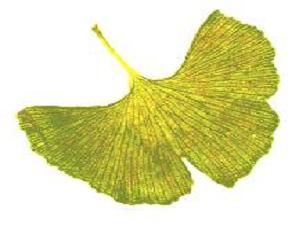Ginkgo: Difference between revisions
imported>Simon Overduin No edit summary |
imported>Simon Overduin mNo edit summary |
||
| Line 9: | Line 9: | ||
Ginkgoes are unique in the plant kingdom, as evidenced by their sole membership of the Ginkgophyta phylum. For one thing, they are possibly the only plants to have [[centriole]]s. Ginkgoes represent the only extant link between lower and higher [[plant]]s because of their method of [[fertilization]], which involves swimming [[sperm]]<ref name=Hori1997 />. | Ginkgoes are unique in the plant kingdom, as evidenced by their sole membership of the Ginkgophyta phylum. For one thing, they are possibly the only plants to have [[centriole]]s. Ginkgoes represent the only extant link between lower and higher [[plant]]s because of their method of [[fertilization]], which involves swimming [[sperm]]<ref name=Hori1997 />. | ||
Ginkgoes are [[dioecious]], though the two | Ginkgoes are [[dioecious]], though the two [[sex]]s are similar in morphology until about 30 years old<ref name=Hori1997 />. Among other identifying characteristics, female trees develop edible but foul-smelling [[seed]]s in the [[autumn]]<ref name=Soma1997>Soma, S. Development of the female gametophyte and the embryogeny of Ginkgo biloba. (1997). In Hori, T. et al (Eds.), ''Ginkgo biloba, a global treasure: from biology to medicine''. New York: Springer-Verlag. pp. 51-65.</ref>. In the [[spring]], older ginkgoes will develop sporangia.They are a resilient species, able to withstand [[city]] [[pollution]] and [[fungus]] and [[insect]] attacks<ref name=Hori1997 />. One ginkgo in [[Hiroshima]] even managed survive the atomic blast that leveled much of the city in [[World War II]]<ref name=Gorman1997>Gorman, C. (1997). More than a funny name. ''Time''. November 3, p. 53.</ref>. | ||
Ginkgoes have important medical applications. It has been reported in the popular press that scientists had found that an extract from Ginkgo leaves, [[EGb 761]], may have a small but significant beneficial effect in treating [[Alzheimer's]] disease. The extract has also been used to treat hearing problems, [[impotence]], [[circulatory system|circulatory]] problems, and [[oxygen]] deprivation<ref name=Gorman1997 />. | Ginkgoes have important medical applications. It has been reported in the popular press that scientists had found that an extract from Ginkgo leaves, [[EGb 761]], may have a small but significant beneficial effect in treating [[Alzheimer's]] disease. The extract has also been used to treat hearing problems, [[impotence]], [[circulatory system|circulatory]] problems, and [[oxygen]] deprivation<ref name=Gorman1997 />. | ||
Revision as of 08:30, 7 January 2008
Ginkgo is the common name for the tree Ginkgo biloba.
The Ginkgo family first appeared 200 to 225 million years ago[1], in the Paleozoic era. Ginkgoes were widespread about 100 million years ago, but now they only exist in a wild state in a remote region in China. However, they have been widely exported to the rest of the world as an ornamental tree, where ginkgoes are also known as "maidenhair" trees[1].
Ginkgos are classed in the Kingdom Plantae, phylum (or division) Ginkgophyta, class Ginkgoopsida, order Ginkgoales, family Ginkgoaceae, genus Ginkgo, species biloba. The ginkgo is the only living member of its phylum.
Ginkgoes are unique in the plant kingdom, as evidenced by their sole membership of the Ginkgophyta phylum. For one thing, they are possibly the only plants to have centrioles. Ginkgoes represent the only extant link between lower and higher plants because of their method of fertilization, which involves swimming sperm[1].
Ginkgoes are dioecious, though the two sexs are similar in morphology until about 30 years old[1]. Among other identifying characteristics, female trees develop edible but foul-smelling seeds in the autumn[2]. In the spring, older ginkgoes will develop sporangia.They are a resilient species, able to withstand city pollution and fungus and insect attacks[1]. One ginkgo in Hiroshima even managed survive the atomic blast that leveled much of the city in World War II[3].
Ginkgoes have important medical applications. It has been reported in the popular press that scientists had found that an extract from Ginkgo leaves, EGb 761, may have a small but significant beneficial effect in treating Alzheimer's disease. The extract has also been used to treat hearing problems, impotence, circulatory problems, and oxygen deprivation[3].
References
- ↑ 1.0 1.1 1.2 1.3 1.4 Hori, T., Ridge, R.W., Tulecke, W., Del Tredici, P., Trémouillauw-Guiller, J., and H. Tobe. (1997). Preface. In Hori, T. et al (Eds.), Ginkgo biloba, a global treasure: from biology to medicine. New York: Springer-Verlag. pp. vii-ix.
- ↑ Soma, S. Development of the female gametophyte and the embryogeny of Ginkgo biloba. (1997). In Hori, T. et al (Eds.), Ginkgo biloba, a global treasure: from biology to medicine. New York: Springer-Verlag. pp. 51-65.
- ↑ 3.0 3.1 Gorman, C. (1997). More than a funny name. Time. November 3, p. 53.
